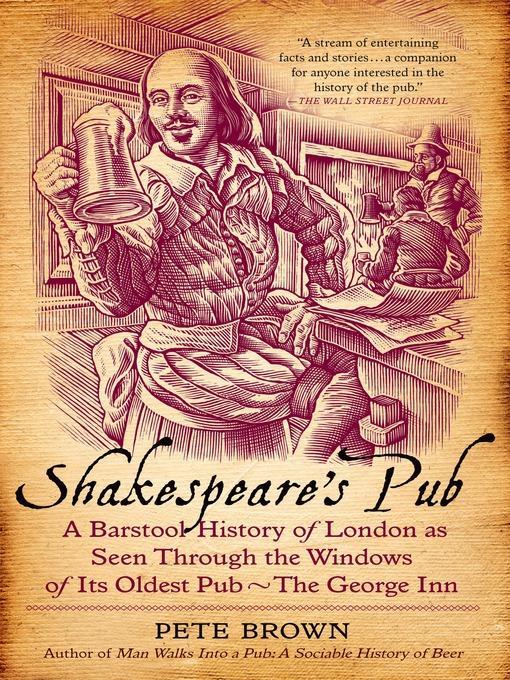
Shakespeare's Pub
A Barstool History of London As Seen Through the Windows of Its Oldest Pub--The George Inn
کتاب های مرتبط
- اطلاعات
- نقد و بررسی
- دیدگاه کاربران
نقد و بررسی

Starred review from March 4, 2013
This rich paean to the venerable George Inn—the last remaining pre-Reformation coaching inn—crackles with literary wit, history, and pop culture. Londoner Brown (Man Walks Into a Pub), who is clearly well versed in the top shelves of bars and libraries, combines his personal knowledge of the place with plenty of research in this light-hearted yet informative portrait of the public house and the centuries of history that have trammeled through and past its doors. While Shakespeare receives dubious top billing—it isn’t clear whether he actually ever visited the pub—Brown runs through a host of other famous patrons, like Charles Dickens and a partying Princess Margaret, as well as the pub’s proprietors, including the incorrigible Agnes Murray, who ran the inn in the 1920s and famously charged Winston Churchill a corking fee for bringing his own port. But this isn’t just a “barstool history” of the goings-on inside the George—Brown also offers a rousing take on the growth of the city outside. Despite the misleading title and occasional detours into the minutiae of historical records and beer trivia, this remains an entertaining tribute to the influence and staying power of a pub—“the primordial cell of British life.” B&w photos throughout. Agent: James Gill, United Agents (U.K.).

March 1, 2013
The centuries-long story of the George Inn, which may not have been Shakespeare's local, but proves fascinating nonetheless. Brown (Man Walks into a Pub, 2004) admits that there's no proof the Bard of Avon ever set foot in the George Inn, but it's the logical place on which to center this book, as it's the only inn that survived fires, the railroads, the Blitz and modernization. The surviving section of the 16th-century pub is a perfectly preserved example of the coaching inns of the past. The author's vast research shows the centrality of these inns to everyday life and commerce. This is actually a history of Southwark, for so many years--nay centuries--the dumping ground for people, businesses and severed heads that the city across the Thames didn't want to deal with. Just as often referred to as "the borough," Southwark sits at the bottom of London Bridge, which until the middle of the 18th century was the only bridge across the Thames. With goods, and especially hops, arriving from the southeast, Southwark became the logistical distribution center of London. As such, inns required large yards for the wagons, coaches and their propulsion units: horses. The inn yards then evolved into the theaters of the area, supporting the plays of Shakespeare, enjoyed from the galleries for those who could afford a penny. The Canterbury Tales, as well as Piers Ploughman, showed the beginnings of the inn as a community gathering place, but Dickens' Mr. Pickwick made the George's name as tourists trolled for links to that most popular author. Brown's wit and extensive research make this a solid book of history, sociology and literature, as well as a great travel guide.
COPYRIGHT(2013) Kirkus Reviews, ALL RIGHTS RESERVED.

Starred review from April 15, 2013
Brown's fourth book on the world of beer is a history of innkeeping in England, because inns found it essential to brew. At the center of the centuries-long story is London's oldest inn, the George, just a hop-skip south of London Bridge in Southwark. The George's heritage is traceable from Chaucer's day, though the Canterbury pilgrims embarked from the Tabard next door, and it figures in Dickens' The Pickwick Papers. Whether Shakespeare patronized the George can't be nailed down, but Southwark was London's theater district, so why not assume? The connections of inns and literature form one strand of Brown's exposition throughout, with wagoning (i.e., hauling goods), quartering both long-term and overnight, victualing, and conventioneering (local councils, clubs, political factions) constituting others. Less enduring but of immense importance is the great age of coaching, from the late seventeenth to the mid-nineteenth century, during which inns flourished as never before or since. As befits his convivial subject, Brown writes as a spellbinding raconteur, keeping to each chapter's topic while taking off on tangents that never prove irrelevant and joking to beat the band but never trying our patience. A book to be read and reread, straight through or piecemeal, chuckling and, ideally, sipping a pint all the while.(Reprinted with permission of Booklist, copyright 2013, American Library Association.)

























دیدگاه کاربران